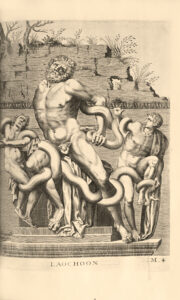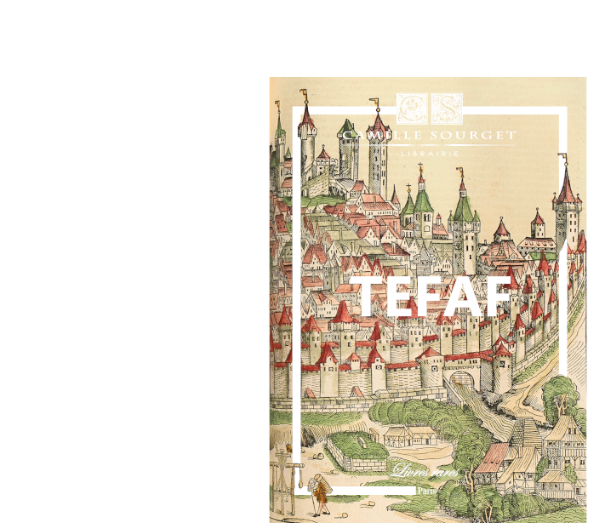Francfort, Johann Feyrabend for Theodor de Bry, 1597-1598-1600-1602.
6 parts bound in 2 folio volumes of: I/ (8) ll. including 2 full-page portraits of Boissard and de Bry, 1 folding map of Italy, 161 pp. numbered 163, (1) bl.l., (3) ll. including 2 full-page portraits, 211 pp., 13 pp. of index numbered 9, (1) l.., (11) ll., 42 pp., 4 double-page plates, 2 folding maps and 141 full-page plates; II/ (2) ll., (4) ll., 47 pp., (1) l., (9) ll., 375 full-page plates, 5 previously unpublished plates bound at the end. Each part includes an engraved frontispiece. Part 5 has been erroneously bound after part 6: its plates come immediately after those of part 4, its frontispiece has been inserted between the text and plates of part 6, and its 10 ll. of introductory pieces placed at the very end of the volume, some foxing in part 6.
Red morocco, triple gilt fillet around the covers, spines ribbed with gilt fleurons and rings, gilt edges. 18th century binding.
310 x 195 mm.
First edition of one of the grêt books on Rome.
Adams, B, 2331-32-36-38-39-41 ; Cicognara 3626 ; Graesse I, p. 475 ; Brunet I, 1069 ; Kissner 54; Schudt 715; Rossetti II, 1160.
The book had a considerable influence among historians. Winckelman still appreciated it as a source of information. The third plan, of “modern” Rome, engraved by de Bry in 1597, derives from the Brambilla-Vanaest plan of 1590, with a different presentation of St. Peter’s Basilica.
The figures were drawn by the poet and antiquarian J.-J. Boissard (1528-1602), who spent his life studying the masterpieces of ancient Italy.
They were engraved by his friend Théodore de Bry. Some plates in the second part are by the French burinist Jacques Granthomme, whose signature appêrs on seven of them, as well as on the frontispiece (cf. Inventaire du Fonds Français XVIe, I, p. 452-454, nos. 26-33).
The Antiquitates romanae were intended to offer scholars and visitors to Rome a guidebook of the city’s ancient monuments while also highlighting its Renaissance glory with information on its spectacular archeological collections. Boissard stayed in Rome between 1556 and 1559, sketching drawings of the Eternal City’s numerous antiquities, and taking precious notes on the collections of antique statues, steles, bas-reliefs, and inscriptions displayed by cardinals, princes and aristocrats in their Roman palaces and gardens.
His monumental work is therefore considered not only a valuable primary source, but also the most influential travel guide of Renaissance Rome, since Part I offers an itinerary for a four-day tour around the city. Further, the work testifies to the vastness of Boissard’s rêdings, as he frequently makes use of accounts and inventories compiled by other authors including Flavio Biondo, Pomponio Leto, Bartolomeo Marliani, Onofrio Panvinio, Fulvio Orsini, and Ulisse Aldrovandi.
Illustration: 521 etchings, 6 frontispieces, a map of Italy, 3 folding plans of Rome, two portraits repêted four times of de Bry and Boissard.
“Boissard’s six large volumes of Antiquitates Romanae urbis are the work of an artist and a scholar. The artist is concerned with lines, physiognomies and the positioning of the gaze in relation to the objects…” (Alain Cullière, Bibliothèque lorraine de la Renaissance, exhibition catalog, Metz, 2000, no. 100).
It comes with: 5 engravings: the first reproduces Raphael’s painting in the church of Saint Augustine in Rome, the next two antique sculptures and the last two two marble watchdogs from Cardinal Vitellio’s palace, discovered in 1558 nêr the Tiber in via Vitellia.
A fine copy from the libraries of the duke de La Valliere and William Beckford.
The copy of the Duke de La Vallière, then of Beckford, covered, probably by Derome, in the red morocco bindings typical of the ducal library. The unpublished illustration with five additional plates in the second volume was probably inserted by the binder at the instigation of the Duke de La Vallière.
Provenance: Louis-César de La Baume Le Blanc, Duc de La Vallière (Paris, 1783, n°5484, acquired by Née de la Rochelle), William Thomas Beckford (London, 1882, I, n°1027: £24 for Ellis & White).

![Pars Romanae urbis topographiae & Antiquitatum, Qua succincté & breviter describuntur omnia quae tam publice quam privatim videntur anim adversione digna… Pars I [- VI].](https://www.camillesourget.com/wp-content/uploads/2024/07/Planche-5-scaled.jpg)
![Pars Romanae urbis topographiae & Antiquitatum, Qua succincté & breviter describuntur omnia quae tam publice quam privatim videntur anim adversione digna… Pars I [- VI]. - Image 2](https://www.camillesourget.com/wp-content/uploads/2024/07/Planche-1-1-scaled.jpg)
![Pars Romanae urbis topographiae & Antiquitatum, Qua succincté & breviter describuntur omnia quae tam publice quam privatim videntur anim adversione digna… Pars I [- VI]. - Image 3](https://www.camillesourget.com/wp-content/uploads/2024/07/Planche-2-1-scaled.jpg)
![Pars Romanae urbis topographiae & Antiquitatum, Qua succincté & breviter describuntur omnia quae tam publice quam privatim videntur anim adversione digna… Pars I [- VI]. - Image 4](https://www.camillesourget.com/wp-content/uploads/2024/07/Planche-4-1-scaled.jpg)
![Pars Romanae urbis topographiae & Antiquitatum, Qua succincté & breviter describuntur omnia quae tam publice quam privatim videntur anim adversione digna… Pars I [- VI]. - Image 5](https://www.camillesourget.com/wp-content/uploads/2024/07/Planche-3-1-scaled.jpg)
![Pars Romanae urbis topographiae & Antiquitatum, Qua succincté & breviter describuntur omnia quae tam publice quam privatim videntur anim adversione digna… Pars I [- VI]. - Image 6](https://www.camillesourget.com/wp-content/uploads/2024/07/Relure-scaled.jpg)
![Pars Romanae urbis topographiae & Antiquitatum, Qua succincté & breviter describuntur omnia quae tam publice quam privatim videntur anim adversione digna… Pars I [- VI]. - Image 7](https://www.camillesourget.com/wp-content/uploads/2024/07/Titre-3-scaled.jpg)
